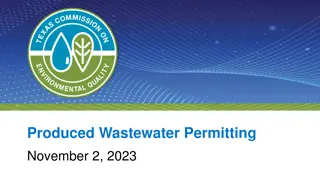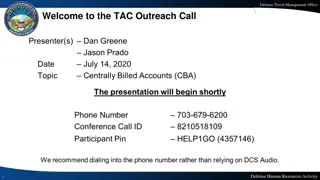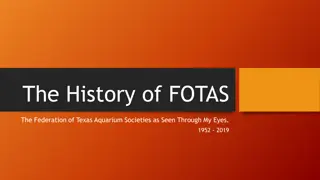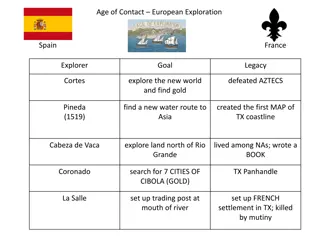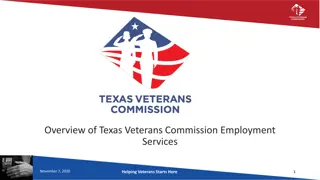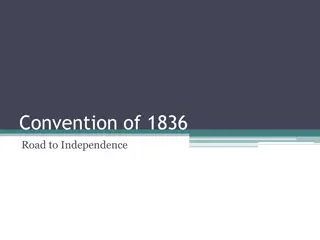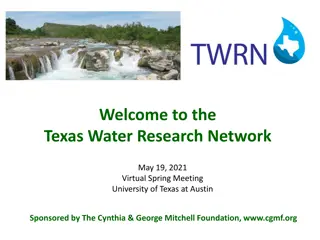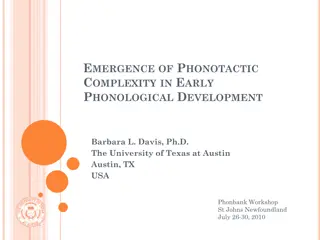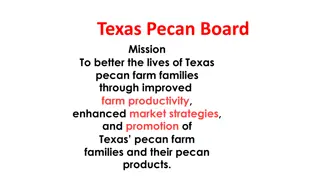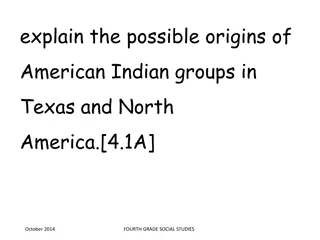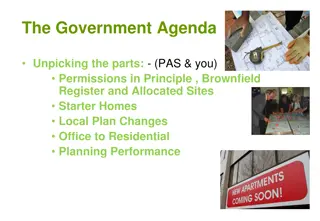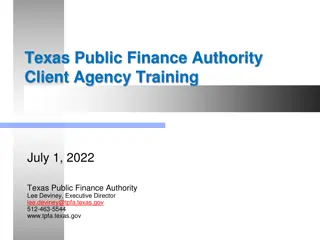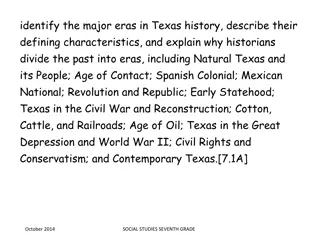Texas Government Development Workshop Agenda July 2020
In July 2020, the Texas Office of Homeland Security conducted a workshop focusing on Homeland Security Strategic Plan Implementation. The agenda included lunch, reviews of IP templates, THIRA and SPR scores, and discussions on best practices amid COVID-19. The workshop aimed to enhance regional planning, identify key risks, and improve preparedness through strategic planning.
Download Presentation

Please find below an Image/Link to download the presentation.
The content on the website is provided AS IS for your information and personal use only. It may not be sold, licensed, or shared on other websites without obtaining consent from the author. Download presentation by click this link. If you encounter any issues during the download, it is possible that the publisher has removed the file from their server.
E N D
Presentation Transcript
2020 T 2020 TEXAS G GOVERNMENTS D DEVELOPMENT EXAS C COUNCILS OUNCILS OF THIRA / SPR / IP EVELOPMENT W WORKSHOP OF OVERNMENTS THIRA / SPR / IP ORKSHOP July 9, 2020 Texas Office of Homeland Security 1
WELCOME Introductions Administrative Issues Agenda Review 2
WORKSHOP AGENDA 12:00 PM 1:30 PM: LUNCH Homeland Security Strategic Plan (HSSP) Implementation Plan (IP) Overview Review of the IP Template IP: Section I (Planning Process, Authorities, Key Personnel) IP: Section II (Preparedness Assessment) IP: Section III (Concept of Implementation) IP: Examples from 2019 Soliciting Input from Regional Partners: Best Practices and Strategies in the Context of COVID-19 9:00 AM: Welcome, Introductions, and Administrative Issues Review of 2019 THIRA / SPR / IP Scores Discussion of 2019 THIRA / SPR / IP Process Feedback Review of the THIRA Template and Approach THIRA: Developing Scenarios, Estimated Impacts, and Capability Targets THIRA: Examples from 2019 Review of the SPR Template and Approach ADJOURN by 4:00 PM SPR: Developing Estimates of Core Capabilities, Capability Change Descriptions, and Capability Gap Descriptions SPR: Examples from 2019 3
WORKSHOP PURPOSE Review the Threat and Hazard Identification and Risk Assessment (THIRA) and Stakeholder Preparedness Review (SPR) format and approach Establish a solid foundation for each COG s THIRA Provide information and clarify requirements for development and submission of the SPR by COGs Provide information on the format and creation of the annual Homeland Security Strategic Plan Implementation Plan (IP) submitted by COGs Discuss the way forward in 2020 4
THIRA / SPR / IP: WHY WE DO THIS Promotes routine, recurring homeland security planning at the regional level in order to ensure coordination among stakeholders, improve understanding of risks and gaps, and focus efforts to enhance preparedness Strengthens strategic planning by identifying the threats and hazards with the greatest impacts to communities Helps to summarize capability gaps in the region and identify needed resources Provides framework for regional and local gap mitigation activities Provides summaries to inform regional SHSP grant prioritization meetings Enhances SHSP grant applications 5
THE THIRA, SPR, AND IP PROCESS During the THIRA process, COGs develop their Capability Targets for each of the 32 Core Capabilities in the National Preparedness Goal. In the SPR, COGs state their current capability levels, and provide a narrative description of capability gaps. COGs use THIRA and SPR data to help develop the HSSPImplementation Plan, which identifies priority tasks that have clear performance measures, completion milestones, and required resources. 6
Review of 2019 THIRA / SPR / IP Scores 7
2019 THIRA / SPR / IP SCORES Average Scores THIRA: 14.94 / 15 SPR: 12.38 / 15 IP: 13.31 / 15 8
2019 THIRA / SPR SCORES VS. 2018 THIRA / SPR SCORES 9
TOTAL 2019 SCORES Average Total 2019 Score: 40.63 / 45 10
TOTAL 2019 SCORESVS. TOTAL 2018 SCORES Average Total 2019 Score: 40.63 / 45 Average Total 2018 Score: 40.07 / 44 11
2019 FEEDBACK REVIEW What were the clearest benefits, if any, of the 2019 THIRA / SPR methodology? The ability to identify which threat and/or hazard challenges the region was a great addition that was useful in facilitating discussion. The new THIRA really streamlined the plan and removed repetitive fillers and inserted some useful stats. These stats are useful in the applications for not just Homeland Security but other grant programs. THIRA Standard Impact Estimates provided a clearer picture of each entity s role in responding to a terrorist, threat, or hazard incident. More specific information requested/required made stakeholders delve into reality. In the SPR, Capability levels (sustained, increased, and decreased) heightened each entity s awareness of their capability level and provided a channel to reflect on accomplishments as well as serving as a tool to alert the challenges needing to be addressed to increase their level. Although quite often, they weren t fully applicable to our region, the fill-in-the-blank target capabilities made the process much easier. That really cut down on the amount of thought that might otherwise be required to develop the statements. 13
2019 FEEDBACK REVIEW What were the greatest difficulties of the 2019 THIRA / SPR methodology? A lot more work and time to complete. The greatest difficulties is always stakeholder participation. When we started this process years ago it was said to influence funding to the region. Now after several years many stakeholders see it as a check the box. Luckily within our region we are seeing a lot of new faces. They don t see these as just check the box therefore they are willing to share their knowledge and opinions. Although quite often, they weren t fully applicable to our region, the fill-in-the-blank target capabilities made the process much easier. That really cut down on the amount of thought that might otherwise be required to develop the statements. Additional comments I realize there s value to using standard language for the Capability Targets. That helps to ensure that all the required elements are found in each statement. That also allows for the appearance of a statewide focus on the same issues coming at the same time from all 24 COGs. But, that also allows us to not really have to think too hard about what each core capability should mean to our respective regions. As far as regional preparedness planning goes, I think there s some value to grappling with those capabilities in order to fully understand how they should and could benefit our regions. 14
THIRA DEVELOPMENT AGENDA Review of the THIRA Template Developing Scenarios Developing Estimated Impacts Developing Capability Targets 16
DEVELOPING SCENARIOS For their 2020 submission, each COG will use at least four threat and hazard scenarios, to include at least: One natural hazard One technological hazard One human-caused threat FEMA Guidance Exclude threats and hazards with only minor impacts, regardless of likelihood Consider threats and hazards resulting in large scale disasters or catastrophic incidents 17
DEVELOPING SCENARIOS Provide a plausible, worst-case scenario description of those threats and hazards that could impact your jurisdiction If you have planned and prepared for the most plausible worst- case threats, you can handle the lesser events Longer is not better Be concise One or two paragraphs is usually sufficient Avoid historical scenarios taken from an All-Hazards Mitigation Plan Demographics, technology, and areas change over time, and scenarios should account for this Scenario impacts are no longer directly tried to Capability Targets Scenario impacts provide context and guidance for Capability Target development 18
DEVELOPING SCENARIOS Factors to consider: Time Day of the Week Season Location Address or latitude/longitude Proximity to residential, coastal, or industrial areas Conditions Wind Speed Wind Direction Humidity Multiple Events? Hazardous Material Release Agent Amount and Rate of Release 19
SCENARIO MODELING TOOLS Tool Purpose Link Hazus Estimating potential losses from earthquakes, floods, and hurricanes, and visualizing the effects of such hazards https://www.fema.gov/hazus HURREVAC Assist the local emergency manager in determining the most prudent evacuation decision time and the potential for significant storm effects such as wind and storm surge http://www.hurrevac.com/ SLOSH Estimate storm surge heights resulting from historical, hypothetical, or predicted hurricanes by taking into account the atmospheric pressure, size, forward speed, and track data https://www.nhc.noaa.gov/surge/sl osh.php Geospatial Information Infrastructure Provides a platform for shared and trusted geospatial data, services, and applications for use by the Homeland Security community https://gii.dhs.gov/gii/home/ ALOHA / CAMEO Integrates a chemical database and a method to manage the data, an air dispersion model, and a mapping capability to plan for and respond to chemical emergencies https://www.epa.gov/cameo 20
THREAT/HAZARD SCENARIOSAND ESTIMATED IMPACTS You can use the same threat and hazard scenarios from previous THIRA documents COGs fill in numbers for relevant standardized impacts (fatalities, people requiring evacuation, people requiring shelter, etc.) for each threat/hazard scenario, using a standardized impact table 21
THREAT/HAZARD SCENARIOSAND ESTIMATED IMPACTS Category Threat/Hazard Scenario Name Terrorism? Choose an item. Choose an item. Scenario Description 22
THREAT/HAZARD SCENARIOSAND ESTIMATED IMPACTS Standardized Impact Estimates (You have the option to include additional impacts, as needed) Impact Category Estimate Impact Category Estimate Partner Organizations Involved In Incident Management Fatalities People Requiring Medical Care Customers (Without Power Service) People Requiring Rescue Customers (Without Water Service) People Requiring Evacuation Customers (Without Communication) Exposed Individuals (Hazmat-Related Incidents) People With Access And Functional Needs (AFN) Affected Structure Fires Miles Of Road Affected Affected Healthcare Facilities And Social Service Organizations Damaged Natural And Cultural Resources And Historic Properties People With Limited English Proficiency Affected People Requiring Food and Water People Requiring Long-Term Housing Businesses Closed Due To The Incident Animals Requiring Shelter, Food, And Water People Requiring Shelter Jurisdictions Affected 23
THREAT/HAZARD SCENARIOSAND ESTIMATED IMPACTS Category Threat/Hazard Scenario Name Terrorism? Technological HAZMAT No Scenario Description At 2:00 PM on a Tuesday, a train carrying liquid chlorine derails in a mixed commercial-residential area. A 90-ton railcar ruptures, spilling approximately 40 tons of chlorine into the surrounding area through a six-foot-wide hole. The liquid chlorine quickly turns to gas and rises into the atmosphere. It is a partly cloudy day, with a temperature of 82 degrees Fahrenheit and 70% humidity. Winds are out of the northwest at 9 mph. 24
THREAT/HAZARD SCENARIOSAND ESTIMATED IMPACTS Standardized Impact Estimates Impact Category Estimate Impact Category Estimate Partner Organizations Involved In Incident Management Fatalities 10 8 N/A People Requiring Medical Care 150 Customers (Without Power Service) N/A People Requiring Rescue 50 Customers (Without Water Service) N/A People Requiring Evacuation 4,000 Customers (Without Communication) N/A Exposed Individuals (Hazmat-Related Incidents) 1,500 Structure Fires People With Access And Functional Needs (AFN) Affected 350 Miles Of Road Affected 10 Affected Healthcare Facilities And Social Service Organizations People With Limited English Proficiency Affected 75 3 Damaged Natural And Cultural Resources And Historic Properties People Requiring Food and Water 2,000 N/A People Requiring Long-Term Housing N/A Businesses Closed Due To The Incident 17 Animals Requiring Shelter, Food, And Water People Requiring Shelter 2,000 N/A Jurisdictions Affected 2 25
THREAT/HAZARD SCENARIOSAND ESTIMATED IMPACTS Category Threat/Hazard Scenario Name Terrorism? Human Caused Complex Coordinated Terrorist Attack Yes Scenario Description On a Friday night in October, citizens crowd into an 8,000-seat high school stadium to watch the Bayville football team face off against their district rivals. It s partly cloudy, with a temperature of 70 degrees Fahrenheit and 50% humidity. Approximately 10 minutes before the scheduled kickoff, an improvised explosive device (IED) concealed in a trashcan near a concessions stand detonates, killing five people instantly and injuring over 20 more. Panic ensues as citizens rush towards the stadium exits, resulting in additional injuries. As the crowd exits the stadium, armed gunmen posted in the parking lot open fire with automatic rifles. 26
THREAT/HAZARD SCENARIOSAND ESTIMATED IMPACTS Standardized Impact Estimates Impact Category Estimate Impact Category Estimate Partner Organizations Involved In Incident Management Fatalities 50 5 People Requiring Medical Care 100 Customers (Without Power Service) N/A N/A People Requiring Rescue 8000 Customers (Without Water Service) N/A People Requiring Evacuation 8000 Customers (Without Communication) N/A Exposed Individuals (Hazmat-Related Incidents) People With Access And Functional Needs (AFN) Affected N/A Structure Fires N/A 200 Miles Of Road Affected Affected Healthcare Facilities And Social Service Organizations People With Limited English Proficiency Affected 200 3 Damaged Natural And Cultural Resources And Historic Properties People Requiring Food and Water N/A N/A People Requiring Long-Term Housing N/A Businesses Closed Due To The Incident Animals Requiring Shelter, Food, And Water N/A People Requiring Shelter N/A N/A Jurisdictions Affected 1 27
THREAT/HAZARD SCENARIOSAND ESTIMATED IMPACTS Category Threat/Hazard Scenario Name Terrorism? Natural Tornado No Scenario Description During the afternoon and evening hours of April 24, a line of severe thunderstorms develops, impacting areas throughout the region. Baseball-size hail is reported. Homes and businesses along the state highway receive significant damage. Several towns are severely impacted. Strong downburst winds damage trees and bring down power lines in and around the county seat, as well as across the region. Over 15,000 customers are without power. On the evening of April 26, a tornado outbreak occurs in the region. A potent storm system brings severe weather and several tornadoes. Early in the morning of April 27, an EF-4 tornado strikes Bayville. Several fatalities are reported with most coming from a multi-car incident on the state highway. Five tornadoes are confirmed over the course of the event, killing 8, injuring over 150 and creating 500,000 cubic yards of debris. Over 100,000 customers are without power across the region. 28
THREAT/HAZARD SCENARIOSAND ESTIMATED IMPACTS Standardized Impact Estimates Estimate Impact Category Impact Category Partner Organizations Involved In Incident Management Customers (Without Power Service) Customers (Without Water Service) Customers (Without Communication) Structure Fires Estimate Fatalities People Requiring Medical Care People Requiring Rescue 12 160 30 8 115,000 0 People Requiring Evacuation Exposed Individuals (Hazmat-Related Incidents) People With Access And Functional Needs (AFN) Affected 15 N/A 50,000 0 1200 Miles Of Road Affected Affected Healthcare Facilities And Social Service Organizations Damaged Natural And Cultural Resources And Historic Properties Businesses Closed Due To The Incident Animals Requiring Shelter, Food, And Water 55 People With Limited English Proficiency Affected 750 10 People Requiring Food and Water 250 0 People Requiring Long-Term Housing 65 35 People Requiring Shelter Jurisdictions Affected 175 4 50 29
THREAT/HAZARD SCENARIOSAND ESTIMATED IMPACTS Points to consider: Impact numbers can be based on real-world events, SME input, stakeholder discussions, recent exercises, existing plans, etc. The numbers aren t expected to be 100% correct. Rather, they should be a reasonable best estimate 30
CAPABILITY TARGET STATEMENTS Target statements are standardized COGs fill in the blanks for each standardized Capability Target statement based on what the region reasonably expects to achieve in the next 3-5 years COGs briefly explain the context/logic behind the Capability Target numbers 31
CAPABILITY TARGET STATEMENTS Planning Capability Target Within every [specify timeframe] update all emergency operations plans that define the roles and responsibilities of [insert number] partner organizations involved in incident management across [insert number] jurisdictions affected, and the sequence and scope of tasks needed to prevent, protect, mitigate, respond to, and recover from events. Capability Target Context Provide a brief paragraphexplaining the logic behind the numbers used in the Capability Target. Numbers could be derived from: Real world events Current plans / capabilities / resources / personnel Geographic area within the region Worst case or most likely scenarios Limitations on further capability development Other factors Which of your identified threats and hazards most challenges the region s ability to achieve this capability target? 32
CAPABILITY TARGET STATEMENTS Planning Capability Target Within every 5 years update all emergency operations plans that define the roles and responsibilities of 25 partner organizations involved in incident management across 15 jurisdictions affected, and the sequence and scope of tasks needed to prevent, protect, mitigate, respond to, and recover from events. Capability Target Context Our region includes 15 jurisdictions, with 25 partner organizations typically involved in emergency and disaster planning and response, including city and county law enforcement agencies; city and county emergency management offices; public health facilities; state law enforcement and emergency management agencies; utilities; and private sector partners. TDEM requires that all Emergency Operations Plans are reviewed and updated every 5 years. Which of your identified threats and hazards most challenges the region s ability to achieve this capability target? HAZMAT 33
CAPABILITY TARGET STATEMENTS Intelligence and Information Sharing Capability Target Within 2 hours of the identification or notification of a credible threat, identify/analyze local context of the threat for the respective area of responsibility, and facilitate the sharing of threat information with 10 priority intelligence stakeholder agencies/entities in accordance with the intelligence cycle, and all dissemination protocols. Capability Target Context During a recent real-world event regarding an active shooter threat at one of our regional middle schools, we needed to share credible threat intelligence with local, county, state, and federal law enforcement and intelligence partners in order to enhance the security posture and identify the potential threat. Similarly, a bomb threat against an airport in our region required regional threat intelligence and information sharing. Which of your identified threats and hazards most challenges the region s ability to achieve this capability target? Complex Coordinated Terrorist Attack 34
CAPABILITY TARGET STATEMENTS Community Resilience Capability Target Every 12 months, conduct 4 outreach events or activities to increase awareness of locally significant threats and hazards to help the residents be more prepared to prevent, protect against, mitigate, respond to, and recover from those events. Capability Target Context Historically, the region faces significant weather-related hazards, such as tornadoes, floods, and wildfires, and our citizens need to be better prepared to face and recover from these threats. Local and regional law enforcement and emergency response agencies need to conduct quarterly outreach activities to raise regional awareness of these threats. Which of your identified threats and hazards most challenges the region s ability to achieve this capability target? Tornado 35
CAPABILITY TARGET STATEMENTS Mass Care Services Capability Target Within 24 hours of an incident, provide emergency sheltering, food, and water for 2,000 people requiring shelter and 2,000 people requiring food and water, including 350 people with access and functional needs (requiring accessible shelter) and 350 people with access and functional needs (requiring food and water), and 100 animals requiring shelter, food, and water. Maintain for 5 days. Within 1 week of an incident, move 500 people requiring temporary, non-congregate housing, including 50 people with access and functional needs (requiring accessible, temporary, non- congregate housing), from congregate care to temporary housing. Capability Target Context Given recent real-world events in the region including a major HAZMAT spill in May 2018 and widespread flooding in April 2019 -- and elsewhere in the state, as well as exercises and workshops conducted in the last 24 months, the above Capability Target represents the mass care capabilities the region aims to build to in the next 3-5 years. The region s PAFN percentage estimate for all impacts and targets is 17.5% (coordinated with HHSC). Which of your identified threats and hazards most challenges the region s ability to achieve this capability target? HAZMAT 36
CAPABILITY TARGET STATEMENTS Points to consider: Capability Target statements are standardized; do not change the language that s been provided COGs only complete one standardized Capability Target statement per Core Capability The targets should be reasonable and justifiable, based on stakeholder experience, subject matter expertise, real world incidents, exercise, plans, and other sources Intent is to require COG THIRA updates every 3 years 37
2019 THIRA EXAMPLES: SCENARIOAND IMPACT ESTIMATES 38
2019 THIRA EXAMPLES: SCENARIOAND IMPACT ESTIMATES 39
2019 THIRA EXAMPLES: SCENARIOAND IMPACT ESTIMATES 40
2019 THIRA EXAMPLES: SCENARIOAND IMPACT ESTIMATES 41
2019 THIRA EXAMPLES: SCENARIOAND IMPACT ESTIMATES 42
2019 THIRA EXAMPLES: SCENARIOAND IMPACT ESTIMATES 43
2019 THIRA EXAMPLES: CAPABILITY TARGETS 44
2019 THIRA EXAMPLES: CAPABILITY TARGETS 45
2019 THIRA EXAMPLES: CAPABILITY TARGETS 46
2019 THIRA EXAMPLES: CAPABILITY TARGETS 47
SPR DEVELOPMENT AGENDA Review of the SPR Template Developing Estimates of Core Capabilities and Capability Change Descriptions Developing Capability Gap Descriptions 49
SPR OVERVIEW COGs estimate current capabilities for each Core Capability based on the Capability Target they developed in the THIRA, using the same standardized format Provide a brief description of any significant capability changes (gains, losses, key sustainment activities) that may have occurred in the region in the last year COGs describe gaps for each Core Capability using relevant POETE elements Capability gap statements should address gaps related to any areas of the Core Capability, and should not be limited to areas specified in the Capability Targets The Capability Gap descriptions in the SPR are the most important aspect of this planning process. 50


